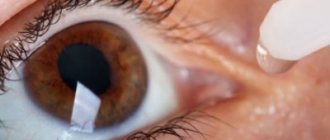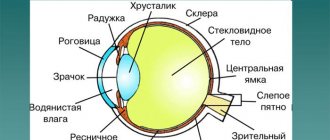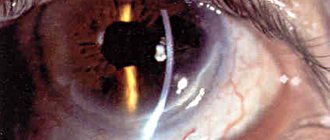Pseudophakia is the presence of an artificial lens in the eye - an IOL, or intraocular lens, and such an eye is called pseudophakic. Intraocular correction is one of the most effective ways to restore clarity of vision in some pathologies of its organs. With it, the old clouded lens is removed and an IOL is placed instead.
Pseudophakia is used for two common disorders - aphakia (anomaly when the natural lens is absent) and cataracts, which result in clouding of the lens). In this case, vision becomes almost 100 percent. The procedure for implanting an artificial lens into a patient for cataracts is called phacoemulsification, it is carried out using ultrasound or using a femtosecond laser.
The lens, depending on its type, can provide good quality vision and a wide peripheral view. With it there are practically no optical aberrations, and the images on the retina are of normal size.
What is pseudophakia?
So let's take a closer look at what it is? Many people believe that pseudophakia is a disease. In fact, pseudophakia is the implantation of an intraocular lens, or IOL implantation for short. The lens is implanted into the visual organ. The procedure can be performed on either one or two eyeballs.
When a person survives an IOL implant, such eyes are called pseudophakic in medical practice.
The introduction of such a lens is carried out through surgery. Many people are afraid of operations, but it should immediately be noted that this procedure has many advantages.
For example:
- The lenses are able to take on the individual physiological shape of the lens.
- With a properly selected lens, it is possible to eliminate the narrowing of the field of view. This method cannot be achieved using glasses, so surgery is the surest way.
Pay attention to the photo, it shows an artificial lens.
Additional advantages of the surgical operation include the absence of distortion of objects.
ICD-10 code
Pseudophakia of the eye is not a disease, and therefore does not have its own code in the international classification of diseases. You can only find disease codes that are associated with artificial lens implantation (for example, lens diseases (H25-H28)).
Pseudophakia of the eye, what is it?
Many people wonder what pseudophakia of the eye actually is, because this procedure has recently become very popular in solving vision problems. This is a kind of surgical operation that removes the “mote” from the eye.
The basis of the operation is the implantation of a new artificial lens , which has a new pseudophakic implant and this is where the name of the operation comes from. Most often, such a procedure is recommended by ophthalmologists to correct vision.
There is nothing painful or dangerous in surgery, so there is no point in being afraid. Pseudophakia has many benefits, especially if you choose between this procedure and glasses.
The bottom line is that this technique does not narrow the field of vision for correction, but, on the contrary, due to the distortion of objects, it creates clarity of objects in normal volume and quality. As a result, you can completely get rid of glasses or contacts.
Pseudophakia allows you to get rid of discomfort when wearing glasses, but before the operation it is recommended to consult a doctor and finally decide to implant an artificial lens.
When is pseudophakia necessary?
Surgery and implantation of a new lens is necessary only when the old one has been damaged. This may happen due to illness or injury. Additionally, pseudophakia may be necessary if a person has been diagnosed with the defect since birth. However, this procedure is only allowed for adults.
The most common cause is eye cataract . Ophthalmologists talk in detail about how the pseudophakia procedure goes, but it is quite difficult to describe the cause of the disease, especially if it is cataract.
Many minds of mankind are struggling to find the cause of the development of cataracts, but there is still no answer. There are only versions from which we can distinguish:
- elderly age;
- congenital disease.
First symptoms
Artifakia of the eye is prescribed only by a qualified doctor, after an accurate diagnosis has been established, but for this you still need to come to him. It is timely seeking help that helps to perform surgery on time and restore lost vision.
As a rule, the first indicators of eye diseases are floaters. That is, when something starts to fly before your eyes, objects become distorted , or your level of vision simply drops, you must definitely seek help from a doctor who will conduct the necessary research and make an accurate diagnosis.
There is no point in delaying treatment of illnesses. Cataracts, like many other eye diseases, can take several years to develop, but most often progress in a matter of weeks . As a result, people almost completely stop seeing and distinguish only light from darkness.
The whole problem is the cloudy lens of the eye , which can be restored with the help of correction. In such situations, glasses or contact lenses no longer help. In addition, alternative or traditional treatments should not be used. This is a waste of time and a chance to develop additional complications, after which even surgery does not help and the person loses his vision forever.
Causes
Why is vision impaired? Damage to the lens can occur due to cataracts, trauma, or a congenital defect.
For a disease such as cataract, a person undergoes pseudophakic eye surgery. It should be noted that scientists still cannot establish the exact causes of such an unpleasant disease. Ophthalmologists most often lean toward a hereditary cause. Some experts say that cataracts occur in old age.
If treatment is not started in a timely manner, the lens gradually begins to become cloudy and becomes dense, so it begins to take up a lot of space. Against this background, a person develops eye pressure.
When is lens replacement surgery prescribed?
The most common pathology that is treated by removing the lens (the transparent body of the eye) is cataract. It often occurs in old age. In severe forms of this disease, pseudophakia becomes the only way to preserve vision. The operation also helps to get rid of other congenital and acquired eye diseases. Indications for pseudophakia:
- defects in the structure of the lens;
- disorders of the transparent body of the eye, causing decreased vision;
- absence of a lens (including at birth);
- mechanical trauma to the organ of vision leading to damage or loss of the lens.
The appointment is made based on the results of the examination. After the decision about the need for surgical intervention is made, the doctor selects a suitable artificial lens. When choosing, the surgeon pays attention to:
- the size of the natural lens that will be removed;
- the size of the chambers of the eye (anterior and posterior);
- general condition of the eyeball;
- the condition of the cornea and lens of a healthy eye, their refractive ability.
Pseudophakia of the eye has a number of advantages over other correction methods:
- preservation of visual fields without their narrowing;
- the resulting image has no contour distortion;
- absence of scotomas (blind areas in the field of vision);
- no additional correction is needed (if surgery is performed on both eyes, the patient will never have to wear glasses or contact lenses).
Symptoms of diseases with pseudophakia of the eye in adults
One of the leading diseases for which an artificial lens is installed is advanced cataracts, when a person almost completely loses vision. The symptoms are pronounced. A person experiences frequent “floaters” before his eyes.
Additional signs:
- darkening of objects;
- the image is distorted.
As soon as such signs occur, you should immediately consult a doctor. Cataracts can develop over several years, and there is a risk of serious complications. Therefore, you should not delay treatment.
When the disease is advanced, the person becomes practically blind. As a rule, such patients can only distinguish whether it is light or dark in a room. In this case, doctors do not prescribe lenses or glasses. With this course of the disease, pseudophakia is prescribed, which will help eliminate all signs of the disease.
Interesting information: previously the operation was performed only for mature cataracts. Now medicine is moving forward, so it is possible to solve the problem at almost any stage of its development.
What kind of lenses can be installed?
In medical practice, there are three types of artificial lenses.
- As a rule, doctors insert anterior chamber lenses into the anterior chamber of the eye. The support when installing the lens is in the corner. Therefore, the lens will come into contact not only with the tissues of the eye, but also with the cornea. It should be noted that in rare cases, after the installation of such lenses, synechiae are formed.
- Pupil lenses are placed exclusively in the eye, for example as a clip. Support for such a lens or front and back. Such lenses, unlike the first ones, have one significant disadvantage. In rare cases, dislocation of the supporting elements is noted, and dislocation of the lens itself may also occur.
- When doctors install a lens in the lens bag for a patient, they are called posterior chamber lenses. Such lenses guarantee excellent quality of vision, and also have the opportunity to strengthen the barrier directly between the back and front of the eye.
Additional benefits of posterior chamber lenses include: they help prevent complications, such as secondary glaucoma or retinal detachment.
In most cases, doctors prefer IOLs that are attached exclusively to the capsule. These lenses are made from a variety of materials. Most often, a hard polymer or leucosapphire is used. If necessary, doctors install lenses with soft material for the patient, which can be made of hydrogel or silicone.
What is the shape of the artificial lens? There are several forms, the first is multifocal, and the second has the appearance of a prism. In severe cases of the disease, doctors insert two intraocular lenses.
Types of lenses
Once the decision has been made to undergo surgery, the question arises about choosing the type of new lens. Of the most common types, there are three types of lenses.
- Anterior chamber lenses are the least commonly used lenses during lens replacement surgery. They are located in the front part of the eye and have direct contact with the cornea and iris of the eye. This contributes to the formation of adhesions in the anterior chamber of the synechia organ and therefore this type of pseudophakia is used extremely rarely.
- Pupil lenses are attached using the clip principle. That is, after removing the nucleus, the implant is attached from the back and front.
- Posterior chamber lenses are installed in the lens bag after the nucleus is removed. This is the main reason why this type of lens is used most often.
There is no need to worry before the operation. Having cast aside all fears and doubts, it is important to remember that pseudophakia can be easily done in any self-respecting clinic. As a result, the operation will help restore the sharpness and vigilance of the eye.
Implant manufacturing process
Before surgery, many clients are asked to choose not only the type, but also the material of artificial lenses that will be implanted into the eyes. There are soft and hard lenses, which mainly differ only in the depth of the puncture for installation.
For example, a soft lens is created using polymethyl methacrylate or lecosapphire , and is implanted to a depth of no more than 2 mm. The hard lens has a base made of silicone, collagen or copolymer and is implanted at a depth of 12 mm. Soft lenses are easier to install, plus the eye is not damaged as much during surgery. The choice is obvious.
An interesting fact is that a surgeon can install two lenses in one eye at once , but why do this? This method is recommended to be used when the optics of the operated eye are almost completely damaged. We are talking about the visual functions of the second organ, which may not work, and then a second lens is additionally installed. He serves as an assistant in dioptrics.
Based on this, implants can be divided into monofunctional and multifunctional . There are differences between them. In the first case, the installation may not completely restore vision. That is, a person will see, but will have to use glasses to read. The second type of lens allows you to completely restore your vision and forget about glasses or contacts forever.
Diagnostics
Before considering how the operation proceeds, it is necessary to first familiarize yourself with the diagnostic measures.
Basic examination plan before surgery:
- A general urine and blood test is prescribed.
- A blood sample is taken for RW.
- Biochemical analysis.
- If necessary, an ECG is prescribed, especially if vision problems arise in old age.
- The focal illumination method is used.
- Intraocular pressure is determined. It can be determined by palpation. But, most often, doctors use the Maklakov method.
Additionally, doctors examine the eye in transmitted light and also determine visual acuity. If necessary, reverse or direct ophthalmoscopy is prescribed.
Differential diagnosis is based on the characteristics described below.
| Main feature | Senile cataract | Acute angle glaucoma |
| Decreased vision in the patient | With this disease, there is a decrease in central vision. | In this case, peripheral vision is already reduced. |
| Side illumination examination | There is a pronounced symptom of “iris shadow”. | No changes may occur. |
| Conductive light | With this research method, a gray fundus reflex is noted. | Pink reflex. |
| Ocular fundus | Since the patient has clouding of the lens, this sign is not detected. | In this case, a marginal excavation of the disc, directly of the optic nerve, occurs. |
| Load test | Negative result | Positive result |
In addition, it is necessary to carry out a differential diagnosis with the types of senile cataracts.
Cause-and-effect relationships
Pseudophakia of the right eye or left eye may be necessary if trauma damages the natural lens. In addition, the examination may reveal a defect that was acquired congenitally. But the most common cause is cataracts. With this disease, it is important to know everything about such a procedure as pseudophakia of the eye, that this is a necessary measure for further good vision. Even modern medicine cannot accurately answer why cataracts develop; some argue that heredity plays a role, while others talk about age and risk factors.
The diagnosis of cataract is made when severe clouding of the lens is detected. As a result, vision deteriorates and the person experiences difficulties. Upon examination, a small spot is discovered that looks like a star. If treatment is delayed or delayed, the “white veil” on the lens becomes denser. Cataracts increase eye pressure and increase the risk of glaucoma, a serious eye disease. Complete loss of visual function is irreversible.
How is the operation performed?
The operation is performed under local anesthesia. In the photo you can see how pseudophakia occurs.
First, the lens is removed, after which the doctor begins to implant the IOL. The operation lasts 40 minutes.
How to treat cataracts? It should be noted that at the time of pseudophakia, cataract excision can be performed in parallel. But, in this case, the patient needs to prepare, as there is a risk of complications. Most often, the body rejects the foreign body. Therefore, it is worth starting cataract treatment on time, this will help prevent its degeneration into a more severe degree of severity.
Pseudophakia is performed on the right, left or both eyes.
Treatment
Depending on the form and severity of the disease, aphakia can be eliminated using conservative or surgical methods. In the first case, correction is used using contact optics (lenses) or glasses.
Aphakia in children requires the most accurate correction of the anomaly to improve visual acuity. Over time, the child’s eyeball grows; therefore, systematic examinations by an ophthalmologist are necessary, who will promptly remove contact optics or glasses.
Unilateral and bilateral aphakia in children is usually corrected with contact lenses. Experts recommend using soft lenses that have high gas permeability and good moisturizing properties.
Important! For children under one year old, lenses made from medical silicone are used.
The disadvantage of contact correction in children is its high cost. The rapid growth of a child requires more frequent replacement of lenses; in addition, the activity of children often causes the loss of contact correction devices.
When using contact optics, complications in children are rare, especially if high-quality lenses are chosen, and parents supervise the wearing and care of them.
In children with bilateral aphakia, spectacle correction may be used. This is a more budget option than good contact lenses. But it is quite difficult for small children to choose glasses - it is difficult for their small nose to withstand the weight of heavy glasses that are inserted into the frame for aphakia.
Intraocular lenses are used in childhood after cataract surgery. If it is congenital, installing an IOL in the first years of a child’s life is impractical, since it is difficult to calculate the lens power in accordance with the child’s growth. In addition, some doctors believe that IOLs can have a negative impact on the physiological development and growth of the child's eye as a whole.
Therefore, surgical intervention is recommended to be carried out no earlier than 2 years - during this period, eye growth has already ended and it is easier for the doctor to calculate the optical power of the lenses.
Consequences and complications
The consequences can be varied, because everything depends on the area of implantation, as well as on the quality of the lens and the condition of the patient’s eye.
Complications:
- Synechia develops.
- Keratitis.
- Secondary glaucoma.
- Lens falls out. At this point, there is a risk of damage to eye tissue.
In rare cases, iridocyclitis develops or retinal detachment occurs. After pseudophakia, you need to be attentive to your health.
Prevention
There are no specific methods for preventing congenital aphakia. To prevent the development of acquired aphakia, it is necessary to undergo an annual preventive examination by an ophthalmologist, who can at an early stage diagnose and begin treatment of diseases that can provoke pathologies requiring surgical removal of the lens.
Those who have a high risk of eye injury due to professional activities are recommended to use protective equipment - masks and goggles - while working.











